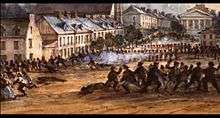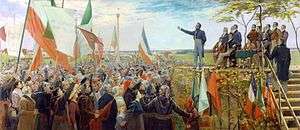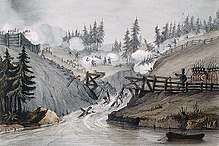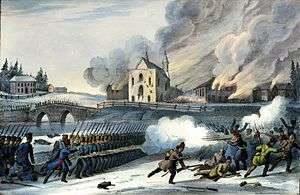Lower Canada Rebellion
The Lower Canada Rebellion (French: rébellion du Bas-Canada), commonly referred to as the Patriots' War (French: Guerre des patriotes) by Québécois, is the name given to the armed conflict in 1837–38 between the rebels of Lower Canada (now southern Quebec) and the British colonial power of that province. Together with the simultaneous rebellion in the neighbouring colony of Upper Canada (now southern Ontario), it formed the Rebellions of 1837–38 (French: rébellions de 1837–38).
As a result of the rebellions, the Province of Canada was created from the former provinces of Lower Canada and Upper Canada.
History
The rebellion was preceded by nearly three decades of efforts at political reform in Lower Canada,[2] led from the early 1800s by James Stuart and Louis-Joseph Papineau, who formed the Parti Patriote and sought accountability from the elected general assembly and appointed governor of the colony. The appointed legislative council (a type of upper house) was dominated by a small group of businessmen known as the Château Clique, the equivalent of the Family Compact in Upper Canada.
Activists in Lower Canada began to work for reform in a period of economic disfranchisement of the French-speaking majority and working-class English-speaking citizens. The rebellion protested the injustice of colonial governing as such, in which the governor and upper house of the legislature were appointed by the Crown. Many of its leaders and participants were English-speaking citizens of Lower Canada. The French speakers felt that Anglophones were disproportionately represented in the lucrative fields of banking, the timber trade, and transportation industry.
At the same time, some among the Anglophone business elite advocated a union of Upper and Lower Canada in order to ensure competitiveness on a national scale with the increasingly large and powerful economy of the United States (some rebels had been inspired by the US' successful war of independence). The unification of the colony was favoured by the British-appointed governor, George Ramsey, Earl of Dalhousie. In Lower Canada, the growing sense of nationalism among English and the French-speaking citizens was organized into the Parti Canadien (after 1826 called the Parti Patriote).

In 1811, James Stuart became leader of the Parti Canadien in the assembly and in 1815, reformer Louis-Joseph Papineau was elected as assembly speaker in Lower Canada. The elected assembly had little power; its decisions could be vetoed by the legislative council and the governor, all of whom were appointed by the British government. Governors Dalhousie and Papineau were soon at odds over the issue of uniting the Canadas. Dalhousie forced an election in 1827 rather than accept Papineau as assembly speaker. Sympathizers to the reform movement in England had Dalhousie forced from his position and reassigned to India. But the legislative council and the assembly were not able to reach a compromise.
After hearing about the 99 grievances submitted by Robert Gourlay, Papineau wrote the "Ninety-two Resolutions" while secretly coordinating with Upper Canada. After protestors were shot in Montreal in 1832, Papineau had no choice but to submit the list of "resolutions" to the governor himself. By 1834, the assembly had passed the Ninety-two Resolutions, outlining its grievances against the legislative council. At that point, the Patriote movement was supported by an overwhelming majority of the Lower Canada population of all origins.
Later in 1834, the Parti Patriote swept the election, gaining more than three-quarters of the popular vote. But, the reformers in Lower Canada were divided over several issues. A moderate reformer named John Neilson had quit the party in 1830 and joined the Constitutional Association four years later. Papineau's anti-clerical position alienated reformers in the Catholic Church, and his support for secular rather than religious schools resulted in opposition by the powerful bishop, Jean-Jacques Lartigue. Lartigue called on all Catholics to reject the reform movement and support the authorities, forcing many to choose between their religion and their political convictions.
Organizing for armed conflict

Papineau continued to push for reform. He petitioned the British government but in March 1837, the government of Lord Melbourne rejected all of Papineau's requests. Papineau organized protests and assemblies, and eventually approved formation of the paramilitary Société des Fils de la Liberté during the assemblée des six-comtés.
The first armed conflict occurred in 1837 when the 26 members of the Patriote movement, who had been charged with illegal activities, chose to resist their arrest by the authorities under the direction of John Colborne.
Papineau escaped to the United States, and other rebels organized in the countryside. Led by Wolfred Nelson, they defeated a British force at Saint-Denis on November 23, 1837. The British troops soon beat back the rebels, defeating them at Saint-Charles on November 25 and at Saint-Eustache on December 14. The troops pillaged and ransacked Saint-Eustache. On December 5, the government declared martial law in Montreal.

When news of the arrest of the Patriote leaders reached Upper Canada, William Lyon Mackenzie launched an armed rebellion in December 1837. In the meantime, filibusters from the United States, the Hunter Patriots, formed a small militia and attacked Windsor, Upper Canada, to support the Canadian Patriots. This resulted in the declaration of martial law by the Lower Canadian government.
The following year, leaders who had escaped across the border into the United States raided Lower Canada in February 1838. Two major armed conflicts occurred when groups of Lower Canadian Patriotes, led by Robert Nelson, crossed the Canada–US border in an attempt to invade Lower Canada and Upper Canada, drive out the British army and establish two independent republics. A second revolt began with the Battle of Beauharnois in November 1838. It was also crushed by forces of the colonial government.
Britain dispatched Lord Durham to investigate the cause of the rebellion. His report in 1839 recommended that the Canadas be united into one colony (the Province of Canada) to assimilate the French-speaking Canadiens into Anglophone British culture. He also recommended acceding to the rebels' grievances by granting responsible government to the new colony.
Aftermath
.svg.png)
Following the military defeat of the Patriotes, Lower Canada was merged with Upper Canada under the Union Act. The Canadiens had a narrow majority in the new political entity, and with continued emigration of English-speakers to Ontario, this dominance was short lived. Eight years after the Union, a responsible elected government was set up in the united Province of Canada. The instability of this new regime (see Joint Premiers of the Province of Canada) eventually led to the formation of the Great Coalition. In 1867, there was another major constitutional change and formation of the Canadian Confederation.
The rebellion of the Patriotes Canadiens of Lower Canada, taken along with the Upper Canadian Rebellion, is often seen as the example of what might have occurred in the United States if the American Revolutionary War had failed. In Quebec, the rebellion (as well as the parliamentary and popular struggle) is now commemorated as the Journée nationale des Patriotes (National Patriotes Day) on the Canadian statutory holiday, Victoria Day. Since the late 20th century, it has become a symbol for the contemporary Quebec independence movement (and to a lesser extent a symbol of Canada's small republican movement).
Leaders
- Thomas Storrow Brown (1803–1888)
- Jean-Olivier Chénier (1806–1837)
- François-Marie-Thomas Chevalier de Lorimier (1803–1839)
- Amury Girod (1800–1837)
- James Ard (1802–1840)
- Edmund Bailey O'Callaghan (1797–1880)
- Wolfred Nelson (1791–1863)
- Louis-Joseph Papineau (1786–1871)
See also
- History of Canada
- Timeline of Quebec history
- Politics of Quebec
- Canada Bay, New South Wales: some French Canadians who took part in the rebellions were expelled to this region of Australia.
- Kahnawake Iroquois and the Rebellions of 1837–38
- February 15, 1839
- Félix Poutré
- List of the 108 Lower Canadians prosecuted before the general court-martial of Montreal in 1838–39
References
- ↑ Andrew Bonthius | The Patriot War of 1837–1838: Locofocoism With a Gun? | Labour/Le Travail, 52 | The History Cooperative Archived 2008-10-11 at the Wayback Machine.
- ↑ Morgan, Jan Henry, Welcome Niall O'Donnell, Immigrant (A Chronicle of Lower Canada: Book One), Chantecler Press, Ottawa, 1992
Further reading
- Boissery, Beverly. (1995). A Deep Sense of Wrong: The Treason Trials, and Transportation to New South Wales of Lower Canadian Rebels after the 1838 Rebellion, Toronto: Dundurn Press, 367 p. ( ISBN 1550022423)
- Brown, Richard. Rebellion in Canada, 1837–1885: Autocracy, Rebellion and Liberty (Volume 1) (2012) excerpt volume 1; Rebellion in Canada, 1837–1885, Volume 2: The Irish, the Fenians and the Metis (2012) excerpt for volume 2
- Buckner, Philip Alfred. (1985). The Transition to Responsible Government: British Policy in British North America, 1815–1850, Westport, Conn.: Greenwood Press, 358 p.
- Burroughs, Peter. (1972). The Canadian Crisis and the British Colonial Policy, 1828–1849, Toronto: MacMillan, 118 p.
- Decelles, Alfred Duclos. (1916). The "Patriotes" of '37: A Chronicle of the Lower Canadian Rebellion, Toronto: Glasgow, Brook & Co., 140 p. [translated by Stewart Wallace]
- Ducharme, Michel. "Closing the Last Chapter of the Atlantic Revolution: The 1837–38 Rebellions in Upper and Lower Canada," Proceedings of the American Antiquarian Society 116 (2):413–430. 2006
- Dunning, Tom. "The Canadian Rebellions of 1837 and 1838 as a Borderland War: A Retrospective," Ontario History (2009) 101#2 pp 129–141.
- Greer, Allan (1993). The Patriots and the People: The Rebellion of 1837 in Rural Lower Canada, Toronto: University of Toronto Press, 385 p. ( ISBN 0802069304) (preview)
- Senior, Elionor Kyte. (1985). Redcoats and Patriotes: The Rebellions in Lower Canada, 1837–38, Ontario: Canada's Wings, Inc., 218 p. ( ISBN 0920002285)
- Mann, Michael (1986). A Particular Duty: The Canadian Rebellions 1837–1839, Salisbury (Wiltshire): Michael Russel Publishing, 211 p.
- Tiffany, Orrin Edward]. (1980). The Relations of the United States to the Canadian Rebellion of 1837–1838, Toronto: Coles Pub., 147 p.
- Ryerson, Stanley Bréhaut (1968). Unequal Union: Confederation and the Roots of Conflict in the Canadas, 1815–1873, Toronto : Progress Books, 477 p.
- Manning, Helen Taft (1962). The Revolt of French Canada, 1800–1835. A Chapter in the History of the British Commonwealth, Toronto: Macmillan Company of Canada, 426 p.
- Kinchen, Oscar Arvle (1956). The Rise and Fall of the Patriot Hunters, Toronto: Burns and Maceachern, 150 p.
- Morison, John Lyle (1919). British Supremacy and Canadian Self-Government, 1839–1854, Toronto: S. B.Gundy, 369 p.
- Schull, Joseph (1971). Rebellion: the Rising in French Canada 1837, Toronto: Macmillan, 226 p.
Primary services
- Greenwood, F. Murray, and Barry Wright (2 vol 1996, 2002) Canadian state trials – Rebellion and invasion in the Canadas, 1837–1839 Society for Canadian Legal History by University of Toronto Press, ISBN 0-8020-0913-1
External links
| Wikimedia Commons has media related to Lower Canada Rebellion. |
- The Patriotes Rebellion Quebec 1837–1839, selection of French documents translated into English for the Marxists Internet Archive
- Les rébellions des Patriotes de 1837–38 (in French)
